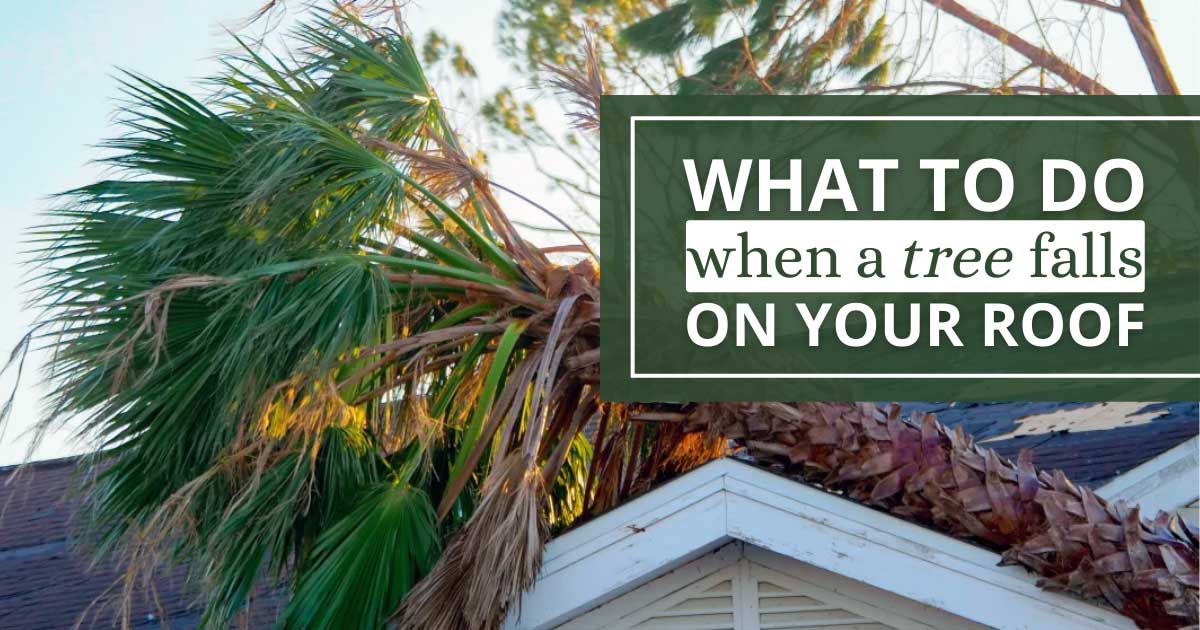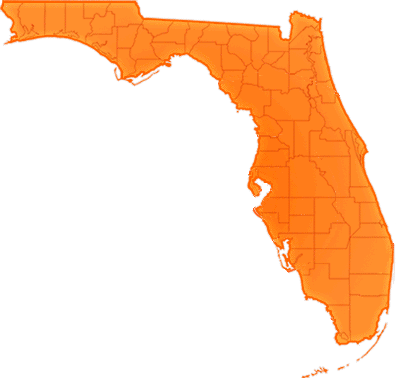What to Do When a Tree Falls on Your Roof
Published: 03/31/2023

Florida’s storm season is fast approaching, and that means you need to be prepared. Knowing what to do when the worst happens is essential to protecting both your family and home, especially in the case of tree falls.
That’s why we’ve compiled this step-by-step guide for what to do when a tree falls on your roof. From the moment it happens to the final repairs, you’ll get a complete walkthrough of the essentials and what to expect.
Evacuate the Home
The moment a tree falls on your home, it’s no longer safe to be inside. The impact could have caused serious damage to the structure, creating a risk of roof cave-ins, wall collapses, and more. You’ll need to get everyone out of the house ASAP. Ask to take shelter at a neighbor’s until you can sort things out.
Of course, if a severe hurricane is making it unsafe to head outdoors at all, then it’s best to move to the other side of the house. Small rooms such as closets and bathrooms are the safest in these scenarios thanks to their compact load-bearing structure.
Assess the Threat
Now that you’re outside, it’s time to look at the impact site and determine how bad the damage is. Be careful not to get too close! If a tree or branch is still on the rooftop or hanging elsewhere, there’s a chance it could fall again. And don’t forget – your home’s structure is still not stable either.
As you’re assessing the damage, make sure to check the following:
- Are there holes in the roof or walls?
- Do any load-bearing structures seem to be compromised?
- Have any power lines been hit or torn down?
- Has the damage affected anywhere gas lines are present?
- Do you smell gas?
- Do you smell smoke?
Call the Authorities
After you’ve made note of what damage and risks are present, you’ll need to call 911 and inform them. It is likely that the fire department will be dispatched to your home to provide immediate help and be on standby until the risk of fire is contained. They may or may not remove the tree or unstable material depending on their protocols. There is a chance the local police may arrive too.
If any electrical wiring has been affected in the fall, you’ll need to call your power company as well. They will be able to send out technicians to shut off the power safely.
Shut Off the Gas
If you’ve identified the possibility of gas lines being damaged, you’ll need to shut off your gas supply just to be safe. Only do this if you can safely access the main shutoff valve and you do not smell gas. Otherwise, it will need to be dealt with by the emergency responders. If you smell gas, you need to get far away from your property. Gas leaks can not only poison anyone nearby, but also cause an explosion and fire.
The gas main can be found right next to the meter, located somewhere on your home’s exterior. Be aware that the valve can only be shut off by using a wrench. For this reason, it is highly recommended that you keep a wrench in your car, shed, or other safe and accessible place outside of the home, along with other emergency supplies.
Document the Damage
Next, you’re going to need to prepare for notifying your home insurance provider of the tree fall. This requires documenting the damage as well as you can, capturing as much detail as possible. Doing so will ensure that your provider honors your whole claim and fully covers every bit of damage that has been done.
Take pictures and videos of the impact site from multiple angles. Be sure to capture any downed power lines, damaged landscaping, and wreckage that has extended beyond the rooftop. If it’s too dark to take clear photos, just get a couple to document the time of the fall, then get the rest during daylight.
You might be wondering: “Why do I need to take photos if my insurance adjuster is already going to do that?”. But it’s a critical step for protecting yourself. If your insurance does not pay out the full amount of your claim, you’ll have your own evidence to support an appeal.
Make a Claim with Your Home Insurance Provider
Finally, it’s time to contact your home insurance provider and submit your claim. Give them a summary of the damage and request an address to send your photos and videos.
Your provider will be able to advise you of the next steps, which usually start with a visit from your claims adjuster. It’s also possible that they will request for you to solicit quotes from contractors yourself. Depending on the terms of your policy, you may have to pay a deductible.
Call a Professional Roofer
While your home insurance provider may suggest working with a particular roofer, you have the freedom to choose the roofer that you feel is most qualified. You can determine this by comparing quotes given after candidates have performed inspections.
Once you’ve decided which roofer will offer the best work, you’ll need to contact them to contain the damage and plan repairs. Be sure to send your insurance provider the results of the contractor’s initial inspection.
Your roofer will cover any openings with tarps or boards. Though you may be able to cover some damage like broken windows on your own, it’s best to leave the major damage for the professionals. An impacted roof is not safe to walk on, but the contractors will have the gear and training necessary to deal with it. After the damage has been contained, your contractor will then chart out the best course of action for fixing your roof.
AKVM Helps Repair Tree-Damaged Rooftops
While tree falls can often be prevented with routine maintenance and pre-storm bracing, they sometimes happen no matter how much you’ve prepared. In any case, you’ll need the help of a trustworthy contractor to get you through this stressful time.
For over 17 years, AKVM has helped homeowners throughout South Florida repair their storm-ravaged rooftops. We use a process that guarantees top quality work, while aiming to get your family back into your home as soon as as possible. Our team offers free inspections and estimates, allowing you to get a quote without any extra expense. AKVM also performs pre-storm inspections and mitigation services to ensure your roof is ready for the upcoming season.
Whether you’d like to make preparations, or you need emergency help now, we’re here for you. Contact us today to schedule a visit from one of our specialists. Call us at (941) 727-3996.
REQUEST A
FREE ESTIMATE

See What Our Customers Are Saying
Recent Posts
Choosing A Multi-residential Roofer
Choosing The Best Roofer
Energy Efficient Roofing Solutions
How Long Does It Take To Replace A Roof?
Debunking 10 Common Roofing Myths
2025 Roofing Tech & Trends
How To Choose Color For Tile Roof
What Is Drip Edge?
What Do Roof Vents & Penetrations Do?
How Roofs Impact Market Value